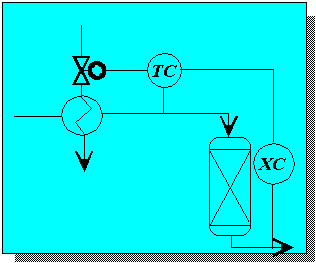Basics of Cascade control
The maximum speed of response, and the ‘tightness’ of control, is tied to the time constants of the controlled process. Where a process response is slow, it isn’t possible to use high gains without running into stability problems. Often, however, these sluggish processes are actually a composite of several lower order, and sometimes much faster, sub-processes.
For example, consider a steam jacketed stirred tank heater. When the steam valve opens the pressure in the jacket rises very quickly, increasing the condensation temperature, and this eventually leads to the liquid exit temperature from the heater rising.
However, the thermal capacity of the jacket is much less than the liquid in the tank, and so the jacket dynamics are much faster than the tank dynamics. In situations like these, and where intermediate measurements of the output from the sub-processes are available, considerable improvements in control can be achieved by using cascade control.
In a cascade control scheme a controller is fitted around the sub-processes which precede the slow part of the process. These controllers are used to quickly eliminate any disturbances arising in these sub-processes without them having a chance to significantly affect the slow process.
Disturbances may also affect the slow process directly and so it is still necessary to attach a controller to the controlled variable, but since the manipulated variable is connected to the sub-process controller, it is necessary to connect the output of the main ( called the primary or master ) controller to the setpoint of the sub-process (secondary or slave) controller.
In the steam-jacketed heater example, a temperature measurement of the jacket temperature would be connected to a temperature controller which manipulated the steam flow. This secondary controller would protect the process against disturbances in the inlet steam pressure, or steam quality, by quickly detecting and correcting changes in the jacket temperature.
The primary controller would still be connected to the liquid outlet temperature, but the controller output would be connected to the jacket temperature controller setpoint, so, if the tank temperature started to fall, the primary controller would demand a higher jacket temperature.
Cascade control is very common in chemical plants. Where flow rates are to be manipulated this is almost always done through a secondary flow controller.
Some examples of cascade control schemes

In this example the concentration from a reactor is being controlled by a concentration controller (XC) which is cascaded to a flow controller (FC) on an input flow to the reactor. With this scheme, the flow controller will quickly deal with any up-stream or down-stream pressure variations which could disturb the flow into the reactor.
The dynamics of the flow loop are very fast - effectively they are the dynamics of the control valve. The concentration controller deals with other disturbances to the outlet concentration (e.g. inlet concentration changes, temperature changes, etc) by requesting the flow controller to change the flow through the reactor. The concentration loop will have relatively slow dynamics due to the large mass hold-up in the reactor.
Cascading onto flow controllers is very common in the process industries. Only in a few cases will the output of a controller (other than a flow controller!) be led directly to a valve - most of the time it will be fed to a secondary flow controller.

In this example the feed to a packed bed reactor is preheated. The concentration is manipulated by changing the amount of preheat. The control arrangement shown cascades the concentration controller to a temperature controller on the heat exchanger.
Provided the heat exchanger dynamics are significantly faster than the reactor dynamics, then this is a very powerful cascade arrangement. The temperature controller will deal with disturbances in the flow and heating quality of the heating medium and will also deal with flow and thermal changes in the reactor feed.